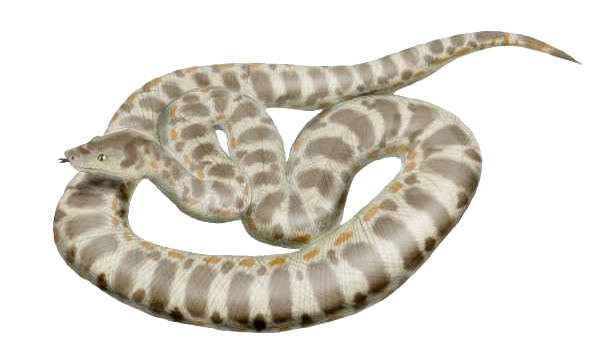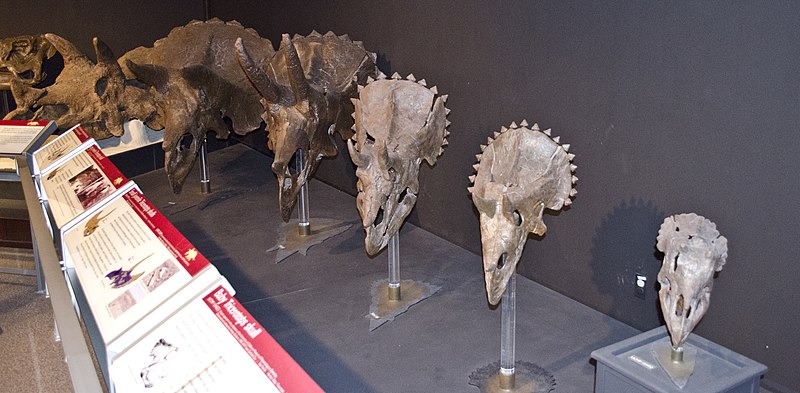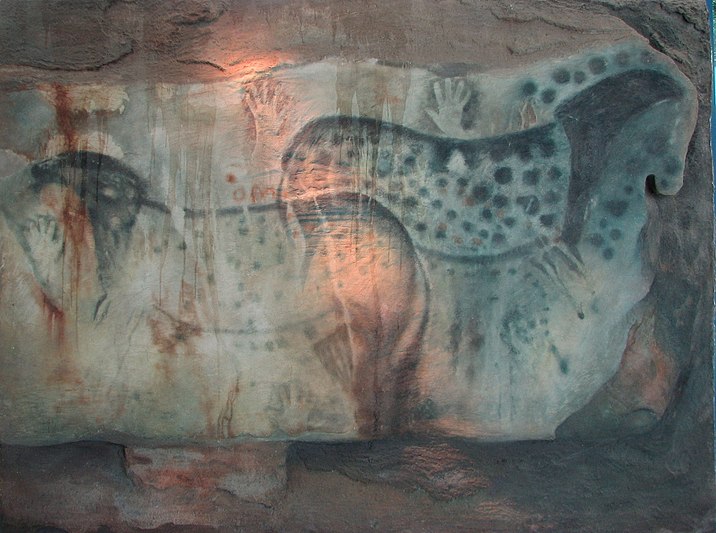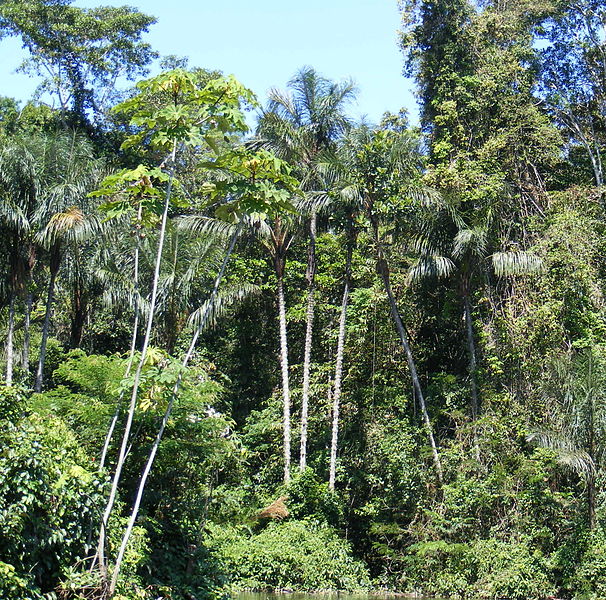Between October 30th and November 2nd, I listened to over 100 talks about the latest research in paleontology. I was at the Society of Vertebrate Paleontology's 73rd Annual Meeting--or "SVP", for short.
Hundreds of paleontologists gathered from around the world to share the latest research, reveal new discoveries, and drink a lot of beer. Throughout each day, 15 minute-long presentations were given back to back to
back. There were three rooms to jump between, which meant there were always three different talks you're forced to choose between. Not easy!
While I left the research world years ago, I still "speak the language"-- and "speaking the language" is pretty much a necessity at these conferences. The complexity of some of the topics demands large and obscure vocabulary.
So I've made this blog post to help translate SVP to non-paleontologists.
------------
.jpg/443px-Archaeopteryx_lithographica_(Berlin_specimen).jpg)
This year at SVP--as there is every year--there was controversy. One of the biggest was the continued debate of whether or not
Archaeopteryx really could fly. One increasingly popular idea is that it may have descended from dinosaurs that could fly, and lost its flight secondarily.
There was also the controversy of a particular tooth type among mammals, known as "hypsodonty", that is claimed to evolve in response to increasing grasslands, but is now shown to have been around before grasslands were prevalent. No one quite knows what this tooth type could've been used for beforehand.
There was even a cheeky suggestion of reviving the genus "
Brontosaurus", because the various species under the genus
Apatosaurus may in fact be varied enough to warrant two genuses, and if that's the case, why not call one of them
Brontosaurus? ...Don't get too excited, though. This idea isn't going anywhere as far as I can tell.
------------
I learned a ton of ways that methodology is changing in paleontology. People are finally seeing that using 3D geo-morphometrics (which has been a popular analysis method this decade) has its drawbacks in addition to its awesomeness.
Paleontologists are becoming extremely conscientious of the ontogeny (growth through life) of species, to avoid future issues like the famous
Torosaurus/Triceratops debate. For instance, more and more paleontologists are using "semaphoronts"--aka individuals of
similar maturity level--when comparing different species to one another,
for most accurate insights into their relationships.
In more computer-y news, 3D scanning is getting awesome enough that scanned fossils can be texture-mapped to look almost exactly like real ones, and that scans will make for sharing of fossils much easier, and even could be used for mapping dig sites.
And a study of why marsupials are underrepresented in fossil fauna showed that they aren't actually underrepresented...but rather that there is bias in how they're reported in literature, because they sit in drawers and often aren't given a species-level identification. Oops.
Finally, the methods of studying footprints is getting an overhaul, with discrete element modeling helping to establish what tracks look like at different depths of the substrate the animal walked on. It's super-cool.
Even the discovery of fossil sites is getting revamped with new predictive computer analyses. Seeing all these new methods kind of blew my mind.
------------
 |
| Titanoboa Artwork by Nobu Tamura |
At the meetings, I also learned more about some of our favorite fossil species.
Beelzebufo, a huge Cretaceous frog, has now been shown to not be quite as huge as first predicted--it's about the size of a modern day African bullfrog (which, if you're not familiar,
are pretty massive). It also has a confusing relationship to living frogs, that is throwing amphibian paleontologists for a loop.
Titanoboa (giant fossil snake), meanwhile, was shown to be even more epically gigantic, thanks to the discovery of a 15 inch-long skull. For reference, anacondas have skulls that are typically 3 inches long.
Therizinosaurs, a wacky branch of theropod dinosaurs, apparently had a great sense of balance and large olfactory capabilities, gigantic claws that could hook and pull things, and a small bite force (better for vegetation).
Big cats lost out at the end of the Pleistocene by being too specialized in their hunting, and now today we don't have nearly as many species, and definitely no saber-tooths.
Troodon continues to impress with its huge brain, showing a cerebrum that is more than 50% of the entire brain mass.
Rudapithecus (an early ape) had delayed maturation based on eruption of its grown-up molars, giving it longer to develop a big ape brain, even though its body size is smaller than most living apes.
And
Eunotosaurus is showing even more signs of being one of the earliest known fossil turtles, thanks to its skull.
------------
I got to see new studies about my favorite topic: limb morphology and locomotion. The ancestors of mammals had a more mobile shoulder than the ancestors of reptiles and birds. This lets us mammals have speedy running cycles, but also means we can't dig as efficiently. Reptiles appear to "swim" more on land, which makes for slow walking...but is fantastic for flying. Go birds!

Also, an analysis of bird limbs showed that large birds don't need a running start to fly, as is
commonly suggested. They can just leap into the air most of the time, which has interesting implications of the evolution of flight in dinosaurs. It's also feasible that juveniles might have flown before adults in evolution, because juvenile and adult birds today have a wide variety of different ways they use their limbs.
------------
New discoveries included the first confirmed
Allosaurus eggs, a new ceratopsian skull that indicates horned dinosaurs dispersed into North America at least one two separate occasions, a baby
Chasmosaurus from Alberta, new postcranial material for several early primates (very rare!), a new primate that demonstrates the split between apes and monkeys 25 million years ago, a massive 11-meter long theropod from Kenya, a nesting ground of actual HATCHED therizinosaur eggs (with such a high hatching success rate, it implies the species guarded its nests), new fossil primate teeth that show an Arabian dispersal route for Old World Monkeys, a new species of big cat in Asia with close relationship ties to modern snow leopards, and the oldest Antarctic land mammal (54 million years old). And that's just a sampling of the new stuff presented! Wow!
------------
And in less category-friendly news, I learned that gators have different bite patterns on bones than crocs, and this could be used as a characteristic to tell who bit what in the fossil record (gators are apparently more destructive when they feed...the pictures were...yikes).

I learned that Cope's Rule ("animals will get bigger and bigger as time goes on, unless there's a serious extinction event") is running out of actual evidence to back it up. Finally.
I learned that there are many more tar pits in the world besides the famous Rancho La Brea tar pits in California, and that it's a mistake to think of tar pits as being "pits"...often, it's just a surface-level covering of tar animals get stuck in, or even tar that covers up animals long after they've died.
And I learned that competition for sea grass was the driving force behind the evolution of sea cows. Which makes beautiful sense.
------------
In looking towards the future, studies demonstrated that larger bodied animals are predisposed to extinction, as we're seeing confirmed today.
Taking this a step further, it was shown that body size decreased sharply during prehistoric global warming events. It also was shown that the amount body sizes changed in a species depended on how drastic of a temperature change occurred. Something to keep in mind, because hey, guess what, we're in a global warming event right now.
In fact, one of the biggest take-home messages was how paleontology has extremely important implications and applications for understanding our world today. At a tweet-up lunch, I asked a group of paleontologists what they wished laypeople would understand better about their field of study. One of the most resounding suggestions was the wish for people to understand just how much the study of the past can help us to create a better future.
So in conclusion, SVP 2013 was a wonderful, eye-opening experience, much like it has been in previous years. I'm so grateful that I got the chance to attend. It's given me a lot to think about, and I hope this summary has given you some food for thought, as well.
Citations for the information above can be found below.
Anemone, R., Emerson, C., Nachman, B. DOES PREDICTIVE MODELING WORK IN THE SEARCH FOR VERTEBRATE FOSSILS? A CASE STUDY FROM THE EOCENE OF WYOMING. Journal of Vertebrate
Paleontology, Program and Abstracts, 2013, Page79.
Begun, D. OLDEST DIRECT EVIDENCE OF DENTAL DEVELOPMENTAL DELAY AND ENCEPHALIZATION IN A LATE MIOCENE HOMININE. Journal of Vertebrate
Paleontology, Program and Abstracts, 2013, Page 85.
Bever, G. and Lyson, T. CRANIAL EVOLUTION AND THE ORIGIN OF TURTLES: INSIGHTS FROM EUNOTOSAURUS AFRICANUS. Journal of Vertebrate
Paleontology, Program and Abstracts, 2013, Page 87.
Carrano, M., Mateus, O., Mitchell, J. FIRST DEFINITIVE ASSOCIATION BETWEEN EMBRYONIC ALLOSAURUS BONES AND PRISMATOOLOITHUS EGGS IN THE MORRISON FORMATION (UPPER JURASSIC, WYOMING, USA). Journal of Vertebrate
Paleontology, Program and Abstracts, 2013, Page 102.
Clementz, M. and Velez-Juarbe, J. ESTIMATING THE STRENGTH OF SIRENIAN AND SEAGRASS ASSOCIATIONS OVER THE CENOZOIC THROUGH PHYLOGENETIC AND STABLE ISOTOPE ANALYSES. Journal of Vertebrate
Paleontology, Program and Abstracts, 2013, Page 108.
Currie, P., Holmes, R., Ryan, M., Coy, C., Koppelhus, E. THE SMALLEST, ARTICULATED CERATOPSID (DINOSAURIA). Journal of Vertebrate
Paleontology, Program and Abstracts, 2013, Page 112.
D'Ambrosia, A., Clyde, W., Fricke, H., Snell, K., Gingerich, P. MAMMALIAN DWARFISM ASSOCIATED WITH THE EARLY EOCENE ETM2 HYPERTHERMAL EVENT, BIGHORN BASIN, WYOMING. Journal of Vertebrate
Paleontology, Program and Abstracts, 2013, Page 112.
Drumheller, S. PHYLOGENETIC TAPHONOMY: SYNTHESIZING BITE MARK DATASETS USING STATISTICAL AND CLADISTIC METHODS. Journal of Vertebrate
Paleontology, Program and Abstracts, 2013, Page 119.
Dunn, R., Rose, K., Kumar, K., Rana, R., Smith, T. NEW PRIMATE POSTCRANIA FROM THE EARLY EOCENE OFVASTAN MINE, GUJARAT, INDIA.
Journal of Vertebrate
Paleontology, Program and Abstracts, 2013, Page 119.
Evans, D., Campione, N., Brink, K., Schott, R., Brown, C. WASTED YOUTH: THE IMPORTANCE OF ONTOGENETICALLY EQUIVALENT SEMAPHORONTS IN DINOSAUR PHYLOGENETIC SYSTEMATICS. Journal of Vertebrate
Paleontology, Program and Abstracts, 2013, Page 124.
Evans, S., Groenke, J., Jones, M., Turner, A., Krause, D. BIG, BAD, AND BIZARRE: NEW MATERIAL OF BEELZEBUFO, A HYPEROSSIFIED ANURAN FROM THE LATE CRETACEOUS OF MADAGASCAR, YIELDS FURTHER SURPRISES. Journal of Vertebrate
Paleontology, Program and Abstracts, 2013, Page 124.
Falkingham, P. and Gatesy, S. USING AVIAN SUBSURFACE 3D FOOT MOTION TO SIMULATE FOSSIL TRACK DIVERSITY. Journal of Vertebrate
Paleontology, Program and Abstracts, 2013, Page 126.
Farke, A., Maxwell, D., Cifelli,R., Wedel, M. BIOGEOGRAPHY OF BASAL NEOCERATOPSIAN DINOSAURS ILLUMINATED BY A SKULL FROM THE CLOVERLY FORMATION (LOWER CRETACEOUS) OF MONTANA. Journal of Vertebrate
Paleontology, Program and Abstracts, 2013, Page 126.
Field, D. and Lynner, C. PRECISE INFERENCE OF AVIALAN FLIGHT ABILITY FROM SHOULDER JOINT DIMENSIONS. Journal of Vertebrate
Paleontology, Program and Abstracts, 2013, Page 127.
Fisher, D., El Adli, J., Calamari, Z. 3D OSTEOLOGY OF THE AMERICAN MASTODON. Journal of Vertebrate
Paleontology, Program and Abstracts, 2013, Page 128.
Gilbert, C., Bibi, F., Hill, A., Beech, M., Rossie, J. EARLY OLD WORLD MONKEYS FROM AFRICA AND ARABIA: IMPLICATIONS FOR THE ORIGINS AND BIOGEOGRAPHY OF MAJOR CERCOPTHECID CLADES. Journal of Vertebrate
Paleontology, Program and Abstracts, 2013, Page 135.
Gould, F. TO 3D OR NOT TO 3D: DO 3D SURFACE ANALYSES IMPROVE ECOMORPHOLOGICAL INFERENCES? Journal of Vertebrate
Paleontology, Program and Abstracts, 2013, Page 137.
Habib, M. EVIDENCE AGAINST RUNNING TAKEOFF IN ARCHAEOPTERYX: BREAKING THE TERRESTRIAL VS. ARBOREAL DICHOTOMY. Journal of Vertebrate
Paleontology, Program and Abstracts, 2013, Page 139.
Haupt, R., Desantis, L. INSIGHTS FROM DENTAL MICROWEAR TEXTURE ANALYSIS INTO THE SURVIVAL OF COUGARS (PUMA CONCOLOR) THROUGH THE LATE PLEISTOCENE EXTINCTION. Journal of Vertebrate
Paleontology, Program and Abstracts, 2013, Page 141.
Head, J., Bloch, J., Moreno-Bernal, J., Rincon Burbano, A., Bourqe, J. CRANIAL OSTEOLOGY, BODY SIZE, SYSTEMATICS, AND ECOOGY OF THE GIANT PALEOCENE SNAKE TITANOBOA CERREJONENSIS. Journal of Vertebrate
Paleontology, Program and Abstracts, 2013, Page 141.
Heers, A. and Dial, K. WINGS VERSUS LEGS IN THE THEROPOD-AVIAN LINEAGE: MECHANISTIC UNDERPINNINGS OF VARIATION IN LOCOMOTOR STRATEGIES. Journal of Vertebrate
Paleontology, Program and Abstracts, 2013, Page 143.
Holroyd, P., Rankin, B., Ferrer, E. THE MYSTERY OF THE MISSING MARSUPIALS AND THE PROBLEM OF DETECTION BIAS. Journal of Vertebrate
Paleontology, Program and Abstracts, 2013, Page 145.
Kemp, M., Hadly, E. SIZE-BIASED EXTINCTION EXHIBITED BY QUATERNARY CARIBBEAN LIZARDS. Journal of Vertebrate
Paleontology, Program and Abstracts, 2013, Page 154.
Kobayashi, Y., Lee, Y., Barsbold, R., Zelenitsky, D., Tanaka, K. FIRST RECORD OF A DINOSAUR NESTING COLONY FROM MONGOLIA REVEALS NESTING BEHAVIOR OF THERIZINOSAUROIDS. Journal of Vertebrate
Paleontology, Program and Abstracts, 2013, Page 156.
Lautenschlager, S. UNRAVELING THERIZINOSAUR PALEOBIOLOGY - A MULTI-ANGLE APPROACH. Journal of Vertebrate
Paleontology, Program and Abstracts, 2013, Page 161.
Mihlbachler, M., Samuels, J. LITTLE TITANS OF THE EOCENE: COPE'S RULE OR SAMPLING ARTIFACT? Journal of Vertebrate
Paleontology, Program and Abstracts, 2013, Page 177.
Moers, T., Gelfo, J., Reguero, M., Lorente, M., Lopez, G. THE OLDEST KNOWN (EARLY EOCENE) MAMMAL FROM ANTARCTICA. Journal of Vertebrate
Paleontology, Program and Abstracts, 2013, Page 182.
Morhardt, A., Ridgely, R., Varricchio, D., Witmer, L. NEW STUDIES OF BRAINCASE ANATOMY, BRAIN SIZE, AND BRAIN STRUCTURE IN THE LATE CRETACEOUS THEROPOD TROODON FORMOSUS (DINOSAURIA: SAURISCHIA) BASED ON CT SCANNING AND 3D VISUALIZATION. Journal of Vertebrate
Paleontology, Program and Abstracts, 2013, Page 181.
Morse, P., Wood, A., Bloch, J. CHANGES IN DENTAL DEVELOPMENT IN TWO HERBIVOROUS MAMMAL TAXA FOLLOWING THE PALEOCENE-EOCENE THERMAL MAXIMUM I THE BIGHORN BASIN, WYOMING. Journal of Vertebrate
Paleontology, Program and Abstracts, 2013, Page 182.
Sereno, P., Isch, A., Conroy, L. SHOULDER GIRDLE ARCHITECTURE: A MAJOR CONSTRAINT IN THE EVOLUTION OF AMNIOTE LOCOMOTION. Journal of Vertebrate
Paleontology, Program and Abstracts, 2013, Page 210.
Sertich, J., O'Connor, P., Seiffert, E., Manthi, F. A GIANT ABELISAURID THROPOD FROM THE LATEST CRETACEOUS OF NORTHERN TURKANA, KENYA. Journal of Vertebrate
Paleontology, Program and Abstracts, 2013, Page 212.
Stevens, N., Seiffert, E., Roberts, E., O'Connor, P. PRIMATE DIVERSITY IN THE LATE OLIGOCENE NSUNGWE FORMATION OF SOUTHWESTERN TANZANIA. Journal of Vertebrate
Paleontology, Program and Abstracts, 2013, Page 220.
Stromberg, C., Dunn, ., Madden, R., Kohn, M., Carlini, A. WHERE HAVE ALL THE GRASSES GONE?: NEW MIDDLE MIOCENE PHYTOLITH RECORDS REVEAL THAT GRASSLANDS PLAYED A MINOR ROLE IN HYPSODONTY EVOLUTION IN SOUTHERN SOUTH AMERICA. Journal of Vertebrate
Paleontology, Program and Abstracts, 2013, Page 222.
Wang, X., Tseng, Z., Slater, G., Takeuchi, G., Li, Q. MIO-PLIOCENE CARNIVORANS FROM WESTERN TIBET AND THE EARLIEST RECORD OF PANTHERINE FELIDS. Journal of Vertebrate
Paleontology, Program and Abstracts, 2013, Page 235.
Wood, A., Velez-Juarbe, J., Bourque, J., Bloch, J., Jaramillo, C. DIFFERENCES IN INFERRED FORAGING BEHAVIOR AMONG EARLY MIOCENE SPECIES OF DIPLOTHERIUM: EVIDENCE FROM A NEW FOSSIL DUGONG FROM THE PANAMA CANAL. Journal of Vertebrate
Paleontology, Program and Abstracts, 2013, Page 240.











.jpg/443px-Archaeopteryx_lithographica_(Berlin_specimen).jpg)



















